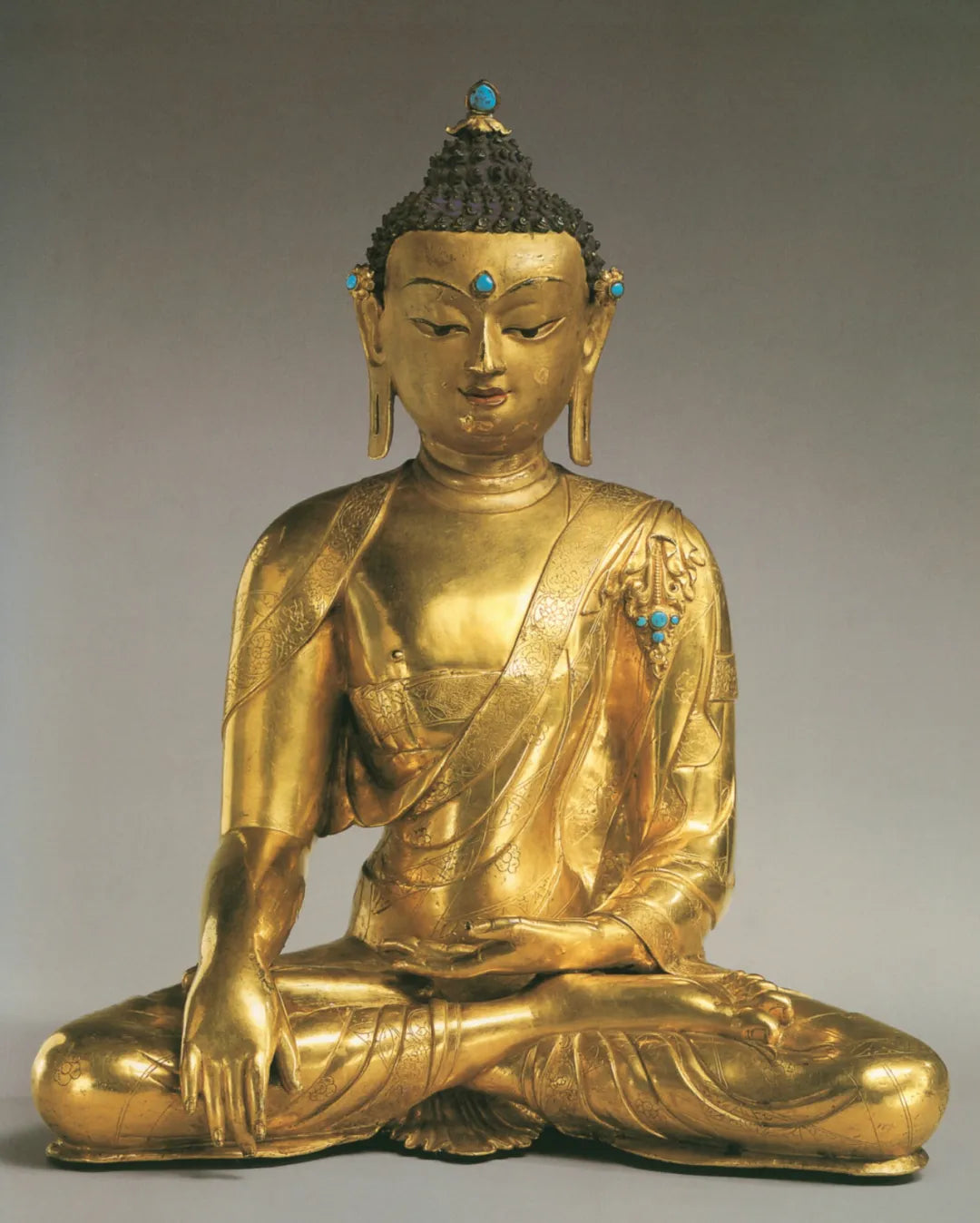
Treasures of the Tibet Series: Gold (གསེར་)

15th century, Private collection
Attributed to the master craftsman of the post-classical period in Tibet
Sonam Jangzam's (བསོད་ནམས་རྒྱལ་མཚན་) stylistic creation

Collected by Jeremy Pine during the former dynasty
Photographed by Mark French
The central animal motif is identified as the native mythical bird "Qiong"
(known as the Garuda in Buddhist context)

In the first half of the 20th century, Losa Menzikang Tibetan Medicine Institute
Portion: "Ae" Gold, Mongolian Gold, and Platinum
གསེར་ནི་ཀླུ་རྒྱལ་ཉ་དང་ཚེ་རིང་བྱ།
བྲུན་ལས་འཛམ་བུ་ཆུ་བོའི་གསེར་ནི་འཐོན།
རྒྱ་མཚོ་ཆེན་པོའི་འགྲམ་གྱི་བྱེ་གསེར་དང།
གུ་ལང་རྡོ་བཞུས་གསེར་དང་བྱང་འབྲོག་གསེར།
ཁམས་གསེར་བོད་གསེར་ཡུལ་གྲུ་ཀུན་ལས་བྱུང།
Produces gold from Zhanbu continent sea
By the sea there is golden sand
"Kulong" melts gold, hidden in the northern region
Tibet and Khampa regions have gold all over
Selected from "The Essentials of Treasure Differentiation"
Lungto Rinpoche Awang Lotsawa
(Klong rdol bla ma; 1719-1794)
Note: "Kurang" is roughly located in present-day Nepal.
The ancient Ali gold is also known as "Kurang gold."
Also, "Kurangba" is interpreted as "pure substance."

"Blue Lapis Lazuli Thangka of Tibetan Medicine: Pharmacological Properties and Functions"
In the first half of the 20th century, Lhasa Menzikang Tibetan Medical Institute
Portion: Bird feces red gold and "Zéqiè Mà Golden"
Note: Bird droppings red gold related to the mythical Longevity Bird
When struck, this gold emits an exceptionally pleasant sound
"Mizuchimah gold" may be related to the dragon fish
Applying black hellebore juice to it creates a rainbow ring

In the first half of the 20th century, Lhasa Menzikang Tibetan Medical Institute
ས་ལས་ཐོན་པ་ཐིག་པ་ཆེ་བྱུང་ན།
ས་ལེ་སྦྲམ་ཟེར་བྱེ་མ་གསེར་ལ་མིན།
བསྲེག་ན་དམར་ཞིང་བརྡར་ན་སེར་བ་དང།
བཅད་ན་དཀར་ཞིང་སྔ་དྲོ་དམར་བ་དང།
ཉིན་གུང་སེར་ཞིང་དགོང་མོ་དཀར་ན་བཟང།
The earth produces a large amount of gold
Good gold "Salezhan" is not sand gold
Burn it red, grind it yellow, cut it white
Red in the morning, yellow at noon, white at night.
(known as premium gold)
Selected from "Essential Collection of Precious Treasures Analysis Methods"
Written by Khenpo Awa Lobsang
(ཀློང་རྡོལ་བླ་མ་;1719-1794)
Note: "Salerjan gold" is considered pure gold
The terms "morning, noon, evening" do not refer to time periods within a day
But to the different shades of gold in various stages of processing.

Artifacts unearthed from the former dynasty in Langkazi County
The "horse-shaped pendant" is not commonly seen in previous archaeological excavations.

During the former dynasty period, the artifact was sourced from the Cultural

From the Tubo Period, Chicago Pritzker Foundation Collection
A Tibetan gold vessel resembling common Eurasian vessel shapes
Their gold artifacts were popular throughout the Eurasian continent in the Middle Ages. In the second year of Xianqing (657 AD), Tubo presented the "Golden City" to the Tang Dynasty. Here, the "Golden City" refers to a building model made entirely of gold, with countless animals and warriors carved on it. It was admired by everyone in the city of Chang'an at that time. For the Tubo people, the golden statuettes were symbols of power, golden vessels were proofs of noble lineage and special status, and using a gold mask for burial after death could allow them to enjoy eternal blessings and unchanging fate in the "Paradise" (བདེ་སྐྱིད་གནས་). Proverbs refer to Tubo as the "Land of Golden Earth".

Created in the second half of the 13th century, held in the Tibet Museum
Measuring 15.3 cm in height, this is a Nepalese-style artwork.

Taken on November 22, 1936
Photographed by Frederick Spencer Chapman
The Stupa of the Fifth and Thirteenth Dalai Lamas adorned with the most gold.

Redeeming the king with gold equal to the weight of his body
Noble girls express their love with golden flowers
These are popular tales about gold in the western Tibetan regions
We generally consider this area as the gold art center of the post-Tubo era.
At least three biographical literature describe the gold mines and goldsmiths here
In the Ali region, gold is referred to as the "son of the stars" in a proverb
(in a rhetorical figure also seen in Persian literature)
Other Tibetan regions also have their own unique gold art
Such as gold processing in the U-Tsang region and gold decoration in the Kham region
"What is pure gold and how to obtain gold"
has always been a focal point of Tibetan craftsmanship works
In addition to those originating from South Asia
Central Asia or the indigenous "gold myths"
later people also mentioned legends originated from North Asia (and Russia)
Distinguishing the gold content of different types of gold raw materials
making gold utensils according to more than a dozen processes
even the alchemy of "turning stone into gold"
Classical Tibetan regions have complete literature and related stories
"Although gold is precious, it should not be taken lightly, forge with a devout heart"
This is the industry principle upheld by the goldsmiths of the past Tibet

From the Ruben Museum in the mid-19th century
Pay attention to the multiple layers of gold or gilded decorations on the throne.

Made in the first half of the 20th century in the Jiangzi region of Shigatse, Tibet
Currently in the collection of the Pitt Rivers Museum in Oxford

"Rare Eight Treasures Gilt-Gold Ga Wu Box with Intricate Designs"
18th Century, Private Collection
Contains a statue of Gautama Buddha
Finding gold while traveling, collecting gold at home, or casually mining for gold
The desire for earthly gold needs to be used appropriately, symbolizing the
The unique qualities of gold allow it to seamlessly integrate into daily religious practices. In Tibetan culture, wise individuals use gold to pay for their studies of Buddhist teachings, despite the high cost being a deterrent for many.
In heavenly realms like the Pure Land, golden rains fall accompanied by golden sands. Wearing gold ornaments can help eliminate toxins and calm the mind.

"Sakya Translator: Jiang Bai Duoji and His Lineage of Masters"
16th century, Rubin Museum
Jiang Bai Duoji (འཇམ་པའི་རྡོ་རྗེ་: 1485-1533)
"Painted with gold or drawn with gold thread"
It is a traditional Tibetan art form
